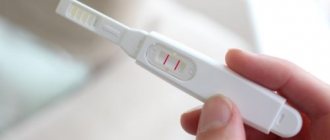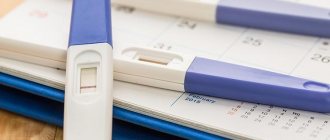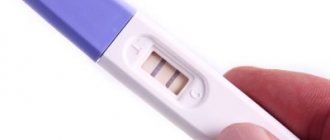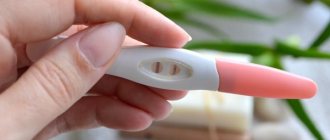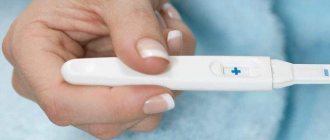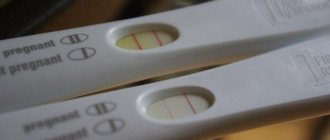Frozen pregnancy
Pain during such a pregnancy begins after detachment of the fertilized egg. The expectant mother may notice the following signs that may indicate a missed pregnancy:
- The toxicosis suddenly went away.
- The mammary glands become painless.
- Basal temperature decreases.
- The pain is cramping in nature.
The diagnosis of “frozen pregnancy” can be made by a doctor after the results of an ultrasound scan.
Problems that are characterized by bloody discharge:
- Risk of miscarriage. When there is a threat of miscarriage, abdominal pain resembles menstruation.
- Placental abruption.
- Ectopic pregnancy.
- The color of the discharge can be different - from pale, pink, to brown.
a week before your period, a test will show pregnancy
— medical portal for online consultations of pediatric and adult doctors of all specialties. You can use the topic 'a week before your period, a test will show pregnancy' and get a free online consultation with a doctor.
Popular articles on the topic: a week before your period, a test will show pregnancy
One of the most used and widely known methods for the early diagnosis of pregnancy is a pregnancy test based on the detection of human chorionic gonadotropin (hCG) in the urine.
Multiple cystic formations that can be seen on the ovaries during ultrasound are not yet a diagnosis. To confidently talk about polycystic ovary syndrome, the doctor must note at least two more symptoms and, based on this, make a decision on treatment.
Questions and answers on: a week before your period, a test will show pregnancy
Hello! The doctor prescribed Polygynax vaginally for 12 days due to severely elevated leukocytes. I was treated approximately from the middle of the cycle before menstruation (as I thought). But my period did not come, the test showed pregnancy. Now I'm worried. The first pregnancy was at risk at 8 weeks. Can Polygynax negatively affect the fetus during 3-4 obstetric weeks, or the quality of attachment of the embryo to the uterus?
Hello, Olesya! Don’t worry, Polygynax should not have a negative effect on the development of the fetus and cannot provoke the threat of miscarriage. Take a folic acid supplement and, if necessary, a progesterone supplement.
Hello! It’s been 4 months since I gave birth) my period started within a month and came twice. But it’s already 2 weeks late and the test showed a barely noticeable second line... could this be pregnancy?
trental tablets during pregnancy During pregnancy, various circulatory disorders may occur, which in any case are primarily dangerous for the fetus. In the second trimester, the expectant mother may develop a complication such as gestosis (or
Hello! My last period was on June 28, 2014 (28 day cycle), and a week after the start of my period I had sexual intercourse. In 3-4
Source
False positive pregnancy test
In the modern world, you can find pregnancy tests in any supermarket or pharmacy. There are many varieties, but they all have one principle - pregnancy tests have a reagent that is sensitive to the hormone human chorionic gonadotropin (hCG) - it is found in the urine of a pregnant woman.
What if the pregnancy test is deceiving?
Two lines on the test - for some this is a long-awaited joy, but for others, on the contrary, longing and sadness. Do not be prematurely upset or, on the contrary, rejoice; it is best to buy the test and take it again. This is exactly the advice gynecologists give. The fact is that when the test shows two lines without pregnancy occurring, then they say: this is a false positive pregnancy test result. What are the reasons for this error?
- There may be problems with the test itself. It may be of poor quality or expired. Sometimes the reason lies in the woman herself. For example, if shortly before taking the test, she was being treated for infertility with hCG drugs, or her treatment involved consuming large amounts of hormones.
- Perhaps the hCG in the urine remains from the woman’s previous pregnancy that was terminated.
- There is a possibility that a false positive result indicates that there are serious health problems in the woman’s body, for example, the presence of an ovarian cyst or tumor (hydatidiform mole or uterine epithelioma).
- To be sure of your condition, take the test again in a few days, and only then consult a doctor.
How to use a pregnancy test without errors?
If a woman uses the test correctly, then its reliability, as manufacturers say, will be 98%. The use of tests of different brands has its own small subtleties. It is best to read the instructions in detail before use. The fact is that some tests need to be immersed in urine, while some tests require urinating.
In one case, the first part of urine is necessary, and in others, the last. Most often, for a pregnancy test, you need to use morning urine - it is more concentrated and there is a higher level of hCG, which is especially important in the early stages of pregnancy. The tests basically have two stripes: one is a control line, it must appear regardless of the result, and the second will only appear if you are pregnant. Please note that if you did not see the required strip, then you need to do another test, since this one turned out to be defective. If, according to the instructions, the strip must be lowered into a container previously filled with urine, you must strictly ensure that it is lowered to a certain level - it is indicated by a line above the arrows
Basically, the test must be kept in the urine for 5 to 30 seconds. Remember that the reaction zone of the test must not be touched. Until the end of the test, nothing should enter this area except the urine required for analysis. The result can be read in just a couple of minutes. In most cases, the control line appears instantly, the second line appears only if there is pregnancy - some time will pass before it appears. Experts advise considering the second stripe as a positive result, even if it is very, very pale. If the second stripe appears later than 10 minutes later, the test is not considered positive. Buy a pregnancy test only in pharmacies, and pay attention to its expiration date. Expired ones mainly show false negative and false positive results. Don’t forget that the test cannot determine whether your pregnancy is normal or ectopic, so after a positive test, immediately visit your gynecologist.
Good afternoon. My problem is that the last critical days were 02/06 to 02/11, the average cycle was 30-32 days, I had protected sexual intercourse. There were delays, but very rarely. I was seen by a gynecologist, she said that it was possible that she was pregnant in the early stages, took a smear, said to take Femibion 1 and sent her for an ultrasound, but not immediately, but after 2 weeks to visit. I did one test, showed a negative result. The first week, instead During my period there was a brown spot, then everything went away. My breasts don’t hurt (although a week before my period it starts to hurt), but my nipples hurt, my lower abdomen is tight, a little nausea, constipation. Can pregnancy occur with protected sexual intercourse, is this even possible?
Guest (not verified)
September 20, 2020 — 13:46
girls, please advise. The first pregnancy was difficult, the birth was also difficult (cesarean). The boy is 1 year and 3 months old. there is a delay and the test showed pregnancy ((2 weeks))). Isn’t it too short a time for a second baby?
Sensitivity
A more accurate way to determine pregnancy before a delay is a blood test for hCG, which can be done in any clinic, because the quantitative indicators of human chorionic gonadotropin initially increase only in the blood, and only then appear in the urine. A blood test 3 days after implantation may show a value from 8 to 26 mU/ml, which will clearly indicate that pregnancy has occurred, since these values exceed the “non-pregnant” norm of 0–5 mU/ml.
Pregnancy tests, widely available not only in pharmacies, but also at supermarket checkouts, have different susceptibility (depending on the amount and type of reagent in the test area). The highest sensitivity systems have a sensitivity level of 10 mU/ml, and the lowest sensitivity - 30 mU/ml. Strip strips with sensitivity to the hormone in urine in amounts of 20–25 mU/ml are usually found on sale.
Do not forget that tests are created to determine the level of human chorionic gonadotropin in the urine, where it increases later than in the blood. Above are the values for the blood test. Thus, the test manufacturers are not lying at all; they say that a woman can use their products with high accuracy only 14–15 days after ovulation, that is, with the onset of the delay.
There are many cases when the test shows a second weak line earlier if, for example, a woman produces hCG at the upper limit of normal or during a multiple pregnancy. But manufacturers do not provide any guarantees regarding the information content and reliability of tests conducted before the delay. If you really can’t wait, you can do a home test (the most sensitive) 2-3 days before the delay. It is possible that the second weak stripe will already appear. But if not, this does not mean that there is no pregnancy, you just need to wait.
Pregnancy or PMS
Signs of a wonderful position are very similar to premenstrual syndrome. Therefore, it is difficult for a woman to determine her condition even before the start of her scheduled period. That's why she buys a test at the pharmacy with the hope of seeing two lines as a reliable sign of her situation.
Characteristic signs reminiscent of pregnancy include:
- frequent mood changes;
- swelling of the mammary glands;
- increased skin sensitivity;
- the appearance of headaches, nausea and vomiting;
- rapid fatigue, desire to sleep;
- feeling of depression;
- change in taste preferences.
If such sensations appear and there is a possibility of becoming pregnant, nothing prevents you from conducting a test. It's better to do this several times in a row. Moreover, today there are not only simple test strips on sale, but more modern devices - cassettes and inkjet tests.
Choosing a test
Having figured out when you can do the first test, when it theoretically shows probable and desirable signs of an “interesting situation,” it’s time to talk about which tests are trustworthy. We have compiled a small rating of such systems based on women’s reviews; it includes names that will help you navigate the wide range.
It should be noted that strip strips, tablet and inkjet tests are mostly disposable. Inkjet ones are considered the most sensitive. Digital tests can be reusable.
Frautest ultrasensitive
The sensitivity is quite high - from 15 mU/ml (or mMKE/ml), it can be used a couple of days before the expected date of menstruation. The strip does not come with a urine collection container. Claimed accuracy is 99%. The system is very affordable and has a lot of positive reviews.
Clearblue Digital
A digital electronic test, the cost of which is quite high compared to standard and familiar strips, but the manufacturers indicate high accuracy, stating that this test is ultra-sensitive (above 99%). The advantage of the test is not only that it shows + or - in the test window, but also that it determines the period, indicating it in weeks.
Will the test show pregnancy before the delay?
The fact that a positive, truthful test result before a missed period is possible is evidenced by numerous life examples, which we have no reason not to trust. Women claim that they intuitively sensed the onset of conception or were guided by the physiological signs of pregnancy when they decided to make such an early diagnosis.
Regardless of your reasons for early detection of conception, the test can indeed be done before the onset of delay. Considering that the devices cannot harm a woman in any way, they can be used every day. But in order for their results to be truthful, you need to adhere to the following rules:
- Before the delay, it is recommended to use only highly sensitive tests that can detect as little as 10 IU of hCG in urine (the smaller the number on the package, the more sensitive the device);
- Diagnosis should be carried out in the morning: at this time the concentration of the hormone in the urine is maximum;
- The results of the first study cannot be considered reliable; they need to be confirmed by repeated diagnostics.
If a long delay is accompanied by a negative test result, you need to contact a gynecologist to find out the reasons. This situation is typical for inflammatory processes in the reproductive system or hormonal imbalance.
5-6 days after conception
Is it possible to find out about pregnancy 5 days after fertilization or even earlier? Definitely not.
Everyone knows that fertilization can only occur during the period of ovulation. After it takes place, the egg begins its journey through the tubes, slowly approaching the walls of the uterus. There the future embryo is securely attached. But this event will occur no earlier than 5 days after conception. Usually implantation occurs on the 7th day, and sometimes on the 10th.
Only after the egg is securely “introduced” into the uterine cavity does its lining begin to produce hCG. Since the concentration of the hormone increases once every two days, simple calculations lead to the fact that tests will be able to detect pregnancy only on the 20th day of the cycle.
So, there is no point in taking a pregnancy test 5-6 days after conception.
7-8 days after conception
You should also not use the test a week after conception. After all, the process of migration and implantation of the egg lasts on average 7 days. Consequently, the egg shell will begin to produce the necessary hormone only on the 8th day after ovulation.
Pregnancy cannot be determined a week after conception. This time is the beginning of hCG production, and its amount is still minimal.
9-10 days after conception
10 days after conception is the period when active production of hCG begins. Let's assume that implantation occurs a week after fertilization. This means that on day 7 the hCG level is 2 IU.
Let's start with simple calculations. Every day the concentration of the hormone doubles. This means that by day 10 it will be only 8 IU. No test can detect pregnancy yet.
11-12 days after conception
Simple examples, in which each day after conception is multiplied by two, allow us to determine that tests can only calculate pregnancy on the 11th day after ovulation. However, these data are not absolute. After all, it is impossible to say with certainty when the journey of the egg ended with its introduction into the uterine cavity. So, if implantation occurred on the 10th day after ovulation, the test will calculate pregnancy only on the 25th day of the cycle.
Accordingly, the fewer days left before the start of the menstrual cycle, the greater the chance of seeing a striped test. Moreover, most women who found out about their conception before the “due date” say that it happened 5 days before their period. 4 days before the delay, the ghost stripe looked much brighter.
See the review on early diagnosis.
1-2 days before menstruation
It would seem that 2 days before your period, an accurate result is guaranteed if you use a highly sensitive test. However, even in this case, the diagnosis may be false. This is all due to the same reasons that we mentioned above: the individual characteristics of the cycle and the time of ovulation.
If late ovulation occurred or the egg “traveled” through the tubes for a long time, the day before the expected menstruation the device will not respond to the hCG level, because it is still too low.
Let's summarize.
A pregnancy test can be used before your period. But the sooner you start using it, the greater the likelihood of error.
What happens after fertilization?
In order for conception to take place, you need to wait for ovulation - only during this short period is a woman capable of fertilization. released from the follicle lives only 24–36 hours , and it is during this period that it can merge with the sperm. Sexual intercourse can be carried out both before and during the ovulation phase. Sperm live longer (up to 3-5 days), and therefore can “wait” until the egg leaves the follicle and becomes available for fusion.
As soon as one of the sperm penetrates the oocyte membrane, it becomes impermeable to the remaining “applicants”, and other sperm gradually die. And the “lucky” one casts off his tail, and the nuclei of the germ cells begin to merge, resulting in the formation of a new cell with its own set of DNA of 46 chromosomes, which contains all the information about what the child will be like: his gender, skin color, eyes, hair, growth and even abilities and talents.
The new cell is called a zygote, and the process of its formation takes up to 12 hours, after which it slowly fragments over three days and at the same time moves through the tube to the uterine cavity. It is set in motion by the villi and contractions of the muscles of the fallopian tube, which literally push the cell forward.
On the 4th day after conception, your baby, who has become a morula, ends up in the uterus . It floats freely for another 1–2 days; approximately 7–8 days after ovulation, it manages to attach to the endometrium. It sticks and gradually sinks into the endometrial layer. This process is called implantation. It lasts about 40 hours. Then the chorionic villi connect with the blood vessels of the mother’s body, the baby, which has become a blastocyst, begins to receive nutrition from the woman’s blood, and a special hormone, hCG, begins to enter the female body. It is produced by the same chorionic villi, hence the name - human chorionic gonadotropin.
Concentrations of the substance increase gradually, doubling every two days. This hormone plays a vital role - it maintains the functional state of the corpus luteum formed on the ovary after the rupture of the follicle, due to which the corpus luteum continues to produce progesterone - a hormone necessary and indispensable for the continuation of pregnancy.
If there was no conception or implantation was unsuccessful, the corpus luteum dies a couple of days before the start of the next menstruation, and menstrual bleeding begins against the background of a sharp decrease in progesterone. But during pregnancy, progesterone levels must remain high, and this is what hCG provides.
Reasons for continuing menstruation during pregnancy
Possible reasons for the absence of a delay during pregnancy may be the following:
- ectopic pregnancy;
- hormonal disbalance;
- superovulation;
- hyperandrogenism;
- genetic abnormalities;
- frozen pregnancy.
It is extremely important to recognize an ectopic pregnancy in the first stages of embryo development, because such a situation is dangerous not only for the child, but also for the mother herself. Only specialists can diagnose an ectopic pregnancy, so if there is no delay, it is recommended to consult a doctor immediately
This category also includes a rather rare phenomenon in which a fertilized egg is implanted in an unfavorable part of the uterus. In this case, there is a high probability of fetal rejection already in the first stages of development, because the embryo cannot receive enough elements necessary for life.
From the moment of conception, a woman’s body undergoes a strong change in the set of hormones produced. If you have periods during pregnancy, the reason for this may be a disturbance in the set of hormones. Hormonal imbalances can manifest themselves in different ways during pregnancy. The most common deviation of this type is an insufficient amount of the hormone progesterone.
Unfortunately, the correct hormonal balance during pregnancy in the modern world is organized less and less, which is why a fairly large number of women face this problem. Today, most hormonal imbalances can be easily corrected with the help of special medications.
Most women's bodies produce only one egg per menstrual cycle. But during superovulation, more than one egg is produced, most often two. In this case, the absence of a delay is not a bad sign, because the fertilized egg develops quietly in the woman’s body, and during menstruation, another female gamete is released, which was formed in parallel. It is worth noting that superovulation does not occur very often.
Hyperandrogenism is a special case of hormonal disorders, but most often it is classified as a separate type due to its prevalence. The phenomenon gets its name from the name of the male hormone androgen. A woman’s body contains a small amount of this substance, and with hyperandrogenism its amount significantly exceeds the norm, which can cause cessation of fetal development or rejection of the embryo. A specialist who has identified this problem usually prescribes medications to the girl to control the level of androgen in the body.
Genetic abnormalities are a problem that many pregnant women face. Deviations of this type can greatly affect the development of the fetus, so a patient with this diagnosis should be under the supervision of specialists for all 9 months.
During a so-called frozen pregnancy, a woman should also be under the supervision of qualified doctors. In most cases, this deviation can be corrected, for which the patient must undergo a course of special therapy.
There are also other reasons for continued menstruation during pregnancy. But doctors do not classify them as a number of serious abnormalities that can harm the mother or child. To protect your unborn child as much as possible from all sorts of dangers, it is best to visit a doctor regularly.
To reduce the risk of termination of pregnancy or the development of congenital defects in the fetus, doctors recommend undergoing examination before conception.
One of the most unpleasant consequences in the absence of a delay is that the woman may not even know that she is pregnant. In this case, there are no special disturbances in the menstrual cycle, and girls may not think about purchasing a special test. When menstruation occurs during pregnancy, the fetus can suffer greatly.
How to determine pregnancy
Previously, it was not possible to find out about pregnancy in the early stages, but today's technologies make it possible. For example, rapid testing is available to everyone, which determines conception using a special test.
These tests are easy to use and sometimes even allow women to determine pregnancy several days before their next menstruation is missed. The newest rapid tests have great sensitivity, which helps to respond to a slight increase in the hormone.
The reason may be a growing belly
Doctors recommend that pregnant women wear a bandage - and this is no coincidence! As the child grows, the size of the abdomen increases. The abdominal muscles are stretched, and a stabbing sensation appears in the abdominal area. This process is easier and more painless for women who play sports. And also for those who are pregnant for the first time. With subsequent ones, some sagging of the abdomen is observed. the same applies to expectant mothers who have a narrow pelvis.
The most important thing for a pregnant woman is to interact with her doctor who is monitoring her pregnancy. Take the necessary tests on time, undergo ultrasound examinations to exclude pathologies and get rid of doubts.
https://youtube.com/watch?v=ANI4AR0HhRo
Why take a test before your period?
The instructions on most pregnancy tests clearly state that it is not prudent to use them before your period. They must be carried out when menstruation has not occurred. Whether a test can show pregnancy before menstruation depends on many factors, including the moment of fertilization.
If you don't want to wait, just buy the test at the pharmacy. For an average test, a content of 25 mIU/mol of homon in your urine is required. However, in recent years, ultra-sensitive new products have begun to appear for early pregnancy detection. Such pregnancy tests help to find out the result before menstruation, even if the hCG level reaches 10 mIU/mol.
Why does my stomach hurt like during menstruation with a positive pregnancy test?
Pregnancy is not only a time of great happiness, but also of great anxiety for the baby. What to do if the test is positive and your stomach hurts like before your period?
If the test showed a positive result very recently, then such pain is physiological. A pulling sensation in the lower abdomen may even indicate pregnancy. They are very similar to menstrual ones and are not (in most cases) dangerous.
To make sure that the discomfort is physiological in nature, a pregnant woman needs to lie down. When the expectant mother relaxes and rests, the pain should completely disappear.
If the pain is aching and constant, the woman should be wary. This is a reason to consult a doctor immediately!
When to test
Processes in the body change under the influence of various factors; even in a completely healthy woman with a regular cycle, the timing of ovulation may differ. There are some nuances in determining pregnancy before the onset of menstruation:
- The cycle lasts longer than normal (from 32). In this case, the cycle is lengthened due to the period when the endometrium is ready for implantation of the egg itself (the first half of the cycle). It would be advisable to carry out the test in the first days after a missed period.
- Short menstrual cycle (less than 24). In this case, there is a possibility that the reaction time of the test to the hormone will change.
- Cycle fluctuations. A common problem for modern women, the causes of which can be: stressful situations, overexertion, colds, etc. If the test is negative and there is no menstruation, it must be repeated.
If the hormone level begins to actively increase, then conception has taken place. Already at the beginning of the expected menstruation, it exceeds the mark of 100 mIU/ml, but since its concentration in the urine is two times lower, it is determined as 50 mIU/ml.
This is not a reason to refuse testing, because modern highly sensitive tests can recognize hCG at low concentrations (10-20 mIU/ml). It follows from this that you can check whether you managed to get pregnant before your period, choosing a test with a high degree of sensitivity.
If you decide to take a pregnancy test before your period, it is recommended to repeat this procedure after some time to obtain an accurate result. If your period has not started, you should consult a gynecologist.
It should be remembered that impatience on the part of a person can be fraught with error and possible unreliable results. The main factor in the reliability of testing is the concentration of hCG, which becomes sufficient to recognize pregnancy after 2 weeks, which approximately corresponds to the first day of delay. Therefore, manufacturers and experts advise carrying out the test on the day of your expected period.
The concentration of hCG in the blood before the delay (in the urine is approximately two times less):
| How long has it been since conception? | How long until the delay? | Wed. value (in blood) |
| 1st day of delay | ||
| 2nd day of delay | ||
| 3rd day of delay |
It is important to understand that using a test strip can only provide preliminary results. Therefore, if the test is negative, do not be upset. The final diagnosis, based on the results of the tests and ultrasound examination, can only be determined by the gynecologist who is seeing the woman.
Tests can be trusted, but trusted wisely
In most cases, the tests are not wrong, but there are a few things to consider when using them.
You shouldn't always trust the claims on the packaging. For example, the instructions for the cheapest test on the Russian market indicate a sensitivity of 20mMe. Although, judging by the reviews of customers, it is not only unable to give an accurate result in advance (before the delay), but is also misleading: the result may be positive even in the absence of pregnancy.
Manufacturers often indicate the prefix “Express” on the packaging of their tests. However, it does not mean that you will know the exact result long before your period. It only guarantees a quick testing procedure. And this is provided that you have everything you need: a container for urine or a pipette (it is not always sold complete with tablet tests).
It is also important to ensure that the test has not expired. It is known that the strips are impregnated with the reagent, and after a while the test may turn out to be positive, even in the absence of a fetus
Sometimes tests show a false result, but the reason does not lie in its poor quality or incorrect use.
False negative. You should take into account the physiological state of your body, due to which the test may show an incorrect result. Medicine knows of cases where a reliable test showed a negative result because the patient consumed more fluid per day than she should. Tests confirmed that the hormone content was 1 ml of urine less than it should have been at her stage of pregnancy. Also, the level of hCG in the urine will be low in case of kidney disease; in this case, only a blood test can establish pregnancy. A negative result can also be obtained if there is a pathology of pregnancy: placental insufficiency, threat of miscarriage, the fetus is not strongly attached to the uterine wall, ectopic pregnancy.
False positive. The test may be positive due to certain diseases of the ovaries, uterus, or due to a tumor - a neoplasm that secretes hCG.
It is worth remembering the individual characteristics of the female body and the numerous factors that disrupt the usual cycle. The hCG level can rise to 25mMe earlier than the expected menstruation, because not all girls and not always ovulate exactly in the middle of the cycle (from menstruation to the next “red days”). Under such circumstances, any test will be positive. Or it may not be possible to establish pregnancy if, for example, due to a cold, the number of days in the cycle has increased or ovulation has shifted. For some women, a long cycle is normal. And the time of ovulation varies from month to month. Such representatives of the fair sex may have different pregnancy periods before the expected delay.
Accuracy of the results obtained
The accuracy of the results depends on the sensitivity of the test:
- Tests that are highly sensitive (10 mIU/ml) can detect conception as early as 5 days before the onset of menstruation. Shows the approximate gestational age.
- Rapid testing with a sensitive range of 20 mIU/ml can be used 3 days before the expected date of the next menstruation.
- Test strips with 25 mIU/ml detect pregnancy two weeks after ovulation.
| Type of test | Description | Advantages | Flaws |
| Test strips | A paper strip impregnated with a special reagent. Urine is collected in a special container where the test is placed for 5-15 seconds. After 5-10 minutes, one (negative) or two stripes (positive) appear on the surface | Inexpensive price, availability - the test can be purchased at any pharmacy |
|
| Jet | Second most common. To obtain results, you must remove the cap and place the fiber rod under a stream of urine. It will show results within a minute after use | There is no need to collect urine. Greater accuracy of results | About 3-5 times more expensive than test strips |
| Tablet | Using a pipette, urine is placed into one of the windows on the front side of the test. The result will be in the second | More expensive and reliable than test strips | Urine must be collected in a container |
| Electronic | The principle of operation is the same as that of the jet test. After use, an hourglass appears first on the LCD screen, and then the inscription: pregnant - pregnant; not pregnant - not pregnant | No need to collect urine, clear results | Expensive. False negatives before delay. The inscription lasts only a few hours, it will not be possible to save it |
Not every woman follows the recommendations for use, and reliability decreases. It is important to read the instructions that come with the test. The optimal time for the procedure is after the first (morning) urination, when the hCG hormone is highest.
Carrying out the procedure during the day or in the evening may give false readings. In this case, you should reduce your fluid intake two hours before the procedure and do not empty your bladder for several hours. Ease of use and accessibility, allows testing every day if necessary.
Three are considered the most accurate:
Is there pregnancy if the second line is pale?
A pregnancy test indicates the presence or absence of pregnancy by the presence of one or two lines, respectively. However, is there really a pregnancy if the second line is pale? There are many such cases, and when one of them happens to a woman personally, many doubts immediately arise about the reliability of the test.
Both stripes on the test can be bright only if the test occurs only after a five-day delay. If you try to determine pregnancy before this period, the stripes may be pale and even barely visible, but this does not mean that the result is negative.
The color and brightness of the strip is influenced by hCG, a special pregnancy hormone, and its concentration. If it is too small, then the stripes will be pale. The cause of the weak color of the stripes may also be problems with the kidneys or a large amount of liquid drunk.
Gynecologists recommend purchasing a more expensive and modern pregnancy test, which can show a clearly defined number of stripes even with a low hCG level, and also checking with a doctor personally to confirm the test result, since it can only be individual for each woman.
Do two lines always mean pregnancy?
When the need arises to determine a false or positive pregnancy result, many people prefer to purchase an inexpensive pregnancy test, believing that if it is meant to be, any identifier will show a reliable result. When two stripes appear, many begin to panic, others rejoice, but do two stripes always mean pregnancy? In order not to remain in doubt for a minute, you need to learn the simple truth that not a single pregnancy test, no matter how expensive and modern it turns out to be, can determine pregnancy 100%.
Of course, you should still be wary and it is better to do a repeat test in a week, as its reliability increases significantly. A control examination should be carried out by a gynecologist, who will examine the woman and prescribe an ultrasound, where the presence of pregnancy and its exact duration will be clearly visible.
The reasons for false-positive pregnancy results consist of many factors, which are based on the woman’s lifestyle, her sex life, the presence of abortions and the use of various medications. All tests show the presence or absence of pregnancy by 97%, the remaining 3% is always kept in reserve by the doctor.
Other early signs of pregnancy
In those days when tests for determining pregnancy did not yet exist, women managed to determine their “interesting position” by signals from their body. Their experience can be used by modern ladies. However, even in this case it is impossible to talk about a standard set of physical sensations: each woman has her own. Even several pregnancies for one mother can proceed differently. Here are some of the most common signs indicating that conception has occurred:
- Enlargement, pain and special sensitivity of the breast;
- Slight dark vaginal discharge during implantation of the egg into the uterine cavity;
- Drowsiness;
- Sudden mood swings;
- Decrease in blood pressure;
- Symptoms characteristic of a cold;
- Nagging pain in the lower abdomen;
- Short-term diarrhea;
- Changes in taste: you want unusual food.
Despite the fact that there are many characteristic symptoms indicating pregnancy, some women do not notice any changes in their body at all.
Many women planning a pregnancy start taking a pregnancy test before their period. It can show a positive result as early as 7 days after conception. But up to 4 days before the delay, the probability of error is very high. Therefore, this is the recommended period for starting testing. The optimal day for the appearance of a clear second stripe is considered to be the day of delay or 2-3 days later. In some cases, you may have to wait longer for results.
Will the test show before the delay?
Not all women want children, but almost all want to know about a possible pregnancy right away. Nowadays, the main tool for determining pregnancy can be considered a home test. If you ask a practicing gynecologist, he will tell you that most of those who came for an appointment about a possible pregnancy have already received a positive test result.
The very first sign of pregnancy is a delay in the onset of menstruation. As a rule, the test is carried out only after menstruation has not occurred. However, some are in a hurry to find out about their situation almost immediately after conception. And the question immediately arises: will the test before a missed period show the correct result? To answer the question in detail, you should know that this instrument analyzes the presence of a specific hormone in a woman’s urine - human chorionic gonadotropin.
Pregnancy test before delay
It is absolutely known that the mentioned hormone begins to be produced in a woman almost immediately after conception, however, its concentration is initially low. In a non-pregnant woman, human chorionic gonadotropin may be present in the body in small quantities - up to 15 IU/l. In a pregnant woman, it is produced in much larger volumes. In the first week - an average of 150 IU/l, in the second and third - 2000 IU/l.
Therefore, it becomes clear that there is a high probability that before the delay, the test will show pregnancy, if any. The study can be carried out at the end of the first week after conception. However, it is worth remembering that the earlier the test is carried out, the greater the likelihood of error. Sometimes two stripes appear on the dough sheet, but one of them is slightly pronounced. In this case, it is impossible to broadcast with confidence that the test is positive. This picture can be observed in several cases. For example, the concentration of the hCG hormone is still low. Therefore, it is advisable to repeat the test after one or two days.
Delayed menstruation a week – test negative
If there is already a delay, the test will be carried out as correctly as possible. However, in this case, inaccuracies are possible. Let us remind you that the reliability of the test reaches a full 97%. Therefore, there is a chance that your result fell into the remaining 3%.
Usually, when menstruation does not return within a week, the saturation of the pregnant woman’s blood with the hormone is already quite high. But there are also exceptions. In addition, various pathologies are possible. For example, a decrease in the level of the hCG hormone may indicate an ectopic pregnancy or the possibility of miscarriage.
If your period is delayed for a month, the test is negative, then in addition to the above reasons, the woman may have malfunctions in the functioning of the body as a whole. For example, disruption of the ovaries, which do not produce the hormone correctly. Thus, a delay in menstruation may well be due to reasons not related to a possible pregnancy
Therefore, it is very important, if your regular menstruation is delayed, to consult a gynecologist, regardless of what the test showed
Increase in the amount of hCG
Before a woman becomes pregnant, the amount of human chorionic gonadotropin in her blood does not exceed 0–5 mU/ml. Accordingly, there is even less of it in urine. If conception does occur and implantation takes place, then for the first time the hormone concentration will exceed the above values approximately 2–3 days after the embryo attaches to the endometrium of the uterus. If we assume that implantation took place on time (the average statistical value is 7 days after ovulation), then the hormone level will change as follows:
- 7 DPO - 2–10 mU/ml;
- 8 DPO - 3–18 mU/ml;
- 9 DPO - 5–21 mU/ml;
- 10 DPO - 8–26 mU/ml;
- 11 DPO - 11–45 mU/ml;
- 12 DPO - 17–65 mU/ml;
- 13 DPO - 22–105 mU/ml;
- 14 DPO - 29–170 mU/ml.
On the first day of the delay, usually the hormone level is already “solid” - from 39 to 270 mU/ml, and errors during testing are practically eliminated.



